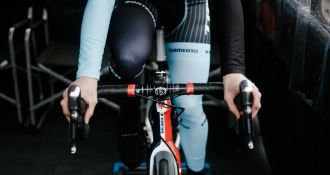

So, first and foremost, what is lactic acid? Lactic acid is a natural byproduct of energy production through the use of the carbohydrate, glucose. Historically, lactic acid is often given a bad rep by grandmothers and club cyclists alike due to the all too familiar burning sensation experienced when we've exercised a little too hard. However, lets put one myth to bed early doors, lactic acid is not the bad guy here; it is in fact the rise metabolites (like hydrogen) and reduced energy (ATP) available which cause that fatigued or burning feeling in the legs. A rise in lactic acid does occur as we exercise harder, but, lactic acid is only guilty by association. However, Lactic acids association with training intensity gives us cyclists, runners and even triathletes a very good clue as to how we can not only train most effectively but also perform more successfully.
When we exercise at low intensities, the body is more proficient at removing blood lactate than it produces, this ensures near resting lactate levels are maintained. The exercise intensity at which lactate clearance is surpassed by lactate production is often termed as the lactate threshold. The lactate threshold highlights the upper limit of exclusive aerobic energy production that allows an athlete or cyclist to exercise for periods in excess of 3 hours (ideal for you readers who like to ride sportives).
At increasing levels of exercise intensities above the lactate threshold there is a second threshold, in which the body can maintain equilibrium between the production and clearance of lactate, this is coined the lactate turnpoint or onset of blood lactate accumulation (OBLA); the latter referring to the power output, heart rate or speed that corresponds with an upturn in lactate acid production above 4mmolŸL.
So what is the relevance of these lactate threshold to us cyclists? Well, if we know what heart rate, speed or power we can ride/run/swim at before our lactate starts to rise and invite all of those bad guys to the party in our muscles, we can prevent ourselves fatiguing prematurely. We have all been there, when we start too hard on a 25-mile time trial, blow up after half an hour, come in 10 minutes slower than expected and eventually buy a set of shiny new wheels with ceramic bearings and a deep 80 mm carbon profile. While we at the Bike Factory love you guys buying new wheels off of us, we have decided to help prevent you blowing up by offering lactate threshold testing. This means when you come to buy those shiny new wheels, you will hopefully be shaving time off of your PB, as opposed to coming within minutes or even seconds of it.
Using a graph like the one below we can assist with your training programs and tailor your race strategy to ensure you are making the most of your precious time.

As you can see from this graph we have two clearly denoted lines, which we can use to aid performance. For example, the line at 360 W (lactate turnpoint) denotes the heart rate and power they can maintain for up to an hour before they capitulate in a ball of their own sweat and tears.
Based on the data gained from the test, we can also determine their training zones (see below) to ensure they are using their time effectively when they are out on the bike.

Even if you're not intent of racing or riding brutal sportives, having your lactate threshold measured is also a good an accurate way to see how well or ineffective your training program has been. After completing a period of training, you should hope to see a shift to the right on the graph above. A movement to the right would suggest you are able to put out more power before you start to fatigue. If there has been no movement or your curve has moved to the left, you can make informed changes to your program to ensure you are making the most of your time and even money if you're paying for a coach.